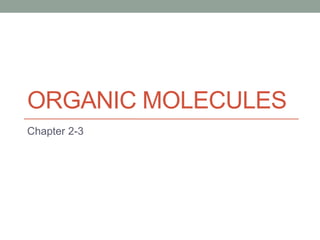
I don't want to give a title on this one but slideshare force me to write so
- 2. Chemistry of Carbon • Carbon forms a variety of different molecules • It has 4 valence electrons and can branch in 4 different directions • It can form long chains with itself • Can be single, double or even triple bonds
- 3. Macromolecules • Many of the molecules in living cells are so large the are called macromolecules • Meaning giant molecules • DNA shown here is an example of a macromolecule
- 4. Macromolecules • Are formed during a process called polymerization • When large molecules are built by joining smaller ones together polymerization Monomer – smaller units Polymer- constructed of many smaller units
- 5. Macromolecules • There are millions of organic molecules formed as the result of carbons versatility as well as polymerization. • There are four groups that all these compounds fall into • Carbohydrates • Lipids • Nucleic acids • Proteins
- 6. Carbohydrates • Organic molecules made up of carbon, hydrogen, and oxygen in a 1:2:1 ratio • Glucose chemical formula C6H12O6 Structural Formula of Glucose Simplified structure
- 7. Carbohydrates • Living things use carbohydrates for their main source of energy. Cellular respiration uses glucose • Plants and some animals also use carbohydrates for “structure” in the form of cellulose
- 8. Carbohydrates • Monosaccharides (C6H12O6) – Simple sugars (monomers) • Glucose • Blood sugar – Produced during photosynthesis. Used as chemical energy in cellular respiration • Fructose • Fruit sugar – very sweet • Galactose • Used in making lactose which is sugar found in mammal milk
- 9. Carbohydrates • Polysaccharides – very large polymers made up of many monosaccharides. Complex Sugars • Glycogen • Starch • Cellulose
- 10. Carbohydrates • Polysaccharides • Glycogen • Found in animals and used for long term storage of energy • Stored in muscles and liver • Excess glucose is stored in this form
- 11. Carbohydrates • Polysaccharides • Starch – long term storage of glucose in plants. Fig 2.13
- 12. Carbohydrates • Polysaccharides • Cellulose – polysaccharide found in plants. Used for structure and found in plant cell walls. Fiber in our diets.
- 13. Proteins • Large macromolecules made up of Carbon, Hydrogen, Oxygen and Nitrogen • Protein (aka polypeptides) are made up of basic building blocks (monomers) called amino acids Central Carbon Carboxyl Group Radical Group Amino Group
- 14. Protein • There are 20 of these monomers in the “protein world” allowing proteins to serve many different function. • R group makes each amino acid different
- 15. Protein Functions • Protein Functions • Structural – hair, tendons, muscle • Enzymes – carry out important chemical reaction in your cells • Antibodies – Form a defense against foreign invaders • Storage – proteins are often stored in seeds and eggs for developing embryos (think egg white) • Signal – Allows cells to communicate (insulin) • Transport – Hemoglobin on RBC carry oxygen
- 16. Protein Structure • How is function decided? Shape or Structure of Protein • Four levels that determine final structure • Primary Structure – the sequence of the amino acid chain (polypeptide) • Formed during dehydration reactions Amino acid Amino Acid Amino Acid Amino Acid Amino Acid Amino Acid Amino Acid Polypeptide Chain
- 17. Protein Structure • Secondary Structure – Chain will fold due to interactions of amino group and carboxyl groups – hydrogen bonds
- 18. Protein Structure • Tertiary Structure – Final 3-D shape taken on by continued folding
- 19. Protein Structure • Quaternary Structure – 2 or more polypeptides put together. Very complex level that not all proteins have.
- 21. Protein – Why Shape Matters Sickle Shaped Blood Cells
- 22. Nucleic Acids • Building Block (monomer) = Nucleotides • Carbon, Hydrogen, Oxygen, Nitrogen, Phosphorus
- 23. Nucleic Acids Polymerization results in polymer - DNA Base Pair Rule Adenine – Thymine Guanine – Cytosine
- 24. Nucleic Acids • Functions • Carry and transmit genetic information • How? • Sequence of nitrogen bases are called genes • Order of nitrogen bases (A,T,G,C) direct the placement of amino acids in the formation of proteins.
- 25. Nucleic Acids • Two types • RNA – Ribonucleic acid • Sugar is ribose • Contains nitrogen base Uracil rather than Thymine • Single Stranded • DNA – Deoxyribonucleic acid • Sugar is deoxyribose • Double stranded
- 27. Nucleic Acids • DNA vs. RNA • DNA contains genes and is master plan. • Passed from parent to offspring • RNA is “blue print” from master plan • Messenger in the process of protein formation video
- 28. Lipids • Building Blocks for fats – 3 fatty acids and 1 glycerol (triglyceride)
- 29. Lipids • Large group of variable molecules that are not soluble in water. • Fats – Most efficient way of storing energy. 9 calories/gram (carbohydrates 4 cal/gram) • Phospholipids – make up cell membranes surrounding cells • Waxes – water proof coverings and things like leaves and insects
- 30. Lipids • Fats can be saturated or unsaturated • Saturated – full of hydrogen on fatty acid chains • Unsaturated – double bonds on fatty acid chains mean less hydrogen
- 31. Lipids
- 32. Lipids • Phospholipids – partially like water, partially don’t like water. Hydrophobic vs. Hydophilic